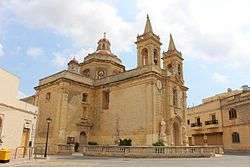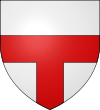Kirkop
| Kirkop Ħal Kirkop | |||
|---|---|---|---|
| Local council | |||
|
The local parish church, dedicated to Saint Leonard | |||
| |||
| Motto: Parva non iners | |||
 | |||
| Coordinates: 35°50′31″N 14°29′6″E / 35.84194°N 14.48500°ECoordinates: 35°50′31″N 14°29′6″E / 35.84194°N 14.48500°E | |||
| Country |
| ||
| Region | Southern Region | ||
| District | South Eastern District | ||
| Borders | Luqa, Mqabba, Safi, Żurrieq | ||
| Government | |||
| • Mayor | Terence Agius (PL) | ||
| Area | |||
| • Total | 1.1 km2 (0.4 sq mi) | ||
| Population (March 2014) | |||
| • Total | 2,191 | ||
| • Density | 2,000/km2 (5,200/sq mi) | ||
| Demonym(s) | Koppi (m), Koppija (f), Koppin (pl) | ||
| Time zone | CET (UTC+1) | ||
| • Summer (DST) | CEST (UTC+2) | ||
| Postal code | KKP | ||
| Dialing code | 356 | ||
| ISO 3166 code | MT-23 | ||
| Patron saint |
Saint Leonard Saint Joseph | ||
| Day of festa |
3rd Sunday of August 2nd Sunday of July | ||
Kirkop (Maltese: Ħal Kirkop) is a small village in the Southern Region of Malta. It is found near the Malta International Airport and has a rich history, dating back to Punic times. The parish church is dedicated to Saint Leonard. Apart from the feast of St. Leonard, a secondary feast of Saint Joseph is celebrated in summer. The village football team, Kirkop United F.C., currently plays in Division 2 of the Malta Football Association competitions.
History and Population growth
The name of the village is derived from an ancient family name that had roots within the area. The village name was known as 'Casal Prokopju' and this name is found in old registers of the militia that existed prior to the coming of the Knights of Malta. It is traditionally known that the name described the place where this family lived. After a while the official name became 'Kirkop' by the local people. Kirkop has been a village before the 11th century and a parish before the 17th century. Punic remains of catacombs are dotted all around the village, and most of them remain undiscovered, but plans state that they will be explored in the future.
In 1969 the anthropologist Jeremy Boissevain published his research on the social fabric of this village in his book Hal Farrug: a village in Malta. The book was republished in 1980 and re-issued under a new title, Ħal Kirkop: A village in Malta, in 2006. In his book, Boissevain identified Ħal Kirkop people whose families had lived in the area for centuries as having the most striking traces of the ancient Phoenician bloodline. The Phoenicians were ancient marauders who had occupied the Maltese islands around 700 B.C. Punic remains of catacombs are dotted all around the village, and most of them remain undiscovered, but plans state that they will be explored in the future. Kirkop was part of a larger community called 'Bir Miftuh' in Middle Ages when on 29 May 1592 it was declared a parish on its own right
The village had a population of 2,260 people in March 2011.[1] By March 2014 this decreased slightly to 2,191 people.[2] It is home of the STMicroelectronics plant, whose production accounts for 60% of the exports in Malta.
Places of Interest
In Kirkop, one finds the Menhir monolith (which has become the symbol of the village), Paleo-Christian Catacombs, the medieval Church of the Annunciation, the Parish Church dedicated to St. Leonard, two band clubs (St. Leonard Band Club and St. Joseph Band Club), and the cemetery inside which there is a chapel dedicated to St. Nicholas.
A cross placed on column is found in Kirkop Square and it is called "Is-Salib tad-Dejma" in Maltese. There is also a quite interesting collection of niches scattered around the village.
Kirkop is also becoming famous and well sought for 'Faux Farming'. Many wealthy and middle-class families are becoming increasing interested in taking up summer residences and buying parcels of land to develop for recreational agriculture activities and outdoor entertaining, mostly due to the relatively low price of land in the south of Malta.
Kirkop main roads
- Triq Ħal Safi (Safi Road)
- Triq il-Belt Valletta (Valletta Road)
- Triq il-Lewżiet (Almonds Street)
- Triq ir-Ramlija (Sandy Street)
- Triq It-Tielet Waqgha (Third Fall Road)
- Triq l-Industrija (Industry Street)
- Triq San Benedittu (St Benedict Street)
- Triq l-Gharaq tad-Demm (Bloody Sweat Street)
- Triq San Ġwann (St John Street)
- Triq San Nikola (St. Nicholas Street)
- Triq Santu Rokku (St Rocco Street)
- Triq Taż-Żebbiegħ (Taz-Zebbiegh Road)
Band clubs
- St Leonard's Band Club (L-Għaqda Mużikali San Leonardu)
- St Joseph Band Club (L-Għaqda Mużikali San Ġużepp)
Zones in Ħal Kirkop
- Bonu ż-Żgħir
- Il-Għadir (The Lake)
- Menħir Estate (Menhir Estate)
- Tal-Aħfar
- Tal-Ibliq
- Tal-Fieres
- Tar-Robba
- Tas-Sienja
Twin village
Climate
The Köppen Climate Classification subtype for this climate is "Csa" (Mediterranean Climate).[4]
Youngest mayor of Kirkop
During the 2015 Local Elections which were held in Ħal Kirkop, Terence Agius, 18, was elected as mayor of the village with 391 votes on the 1st count. He was the youngest candidate to get elected as mayor and the youngest mayor that Ħal Kirkop has ever had.[5]
References
- ↑ "Population statistics" (PDF). Malta Government Gazette. mjha.gov.mt. 9 August 2011.
- ↑ "Estimated Population by Locality 31st March, 2014". Government of Malta. 16 May 2014. Archived from the original on 21 June 2015.
- ↑ Site Officiel de la Mairie de Rousset sur Arc
- ↑ Climate Summary for Ħal Kirkop
- ↑ http://www.timesofmalta.com/articles/view/20150418/local/18-year-old-elected-mayor.564472


